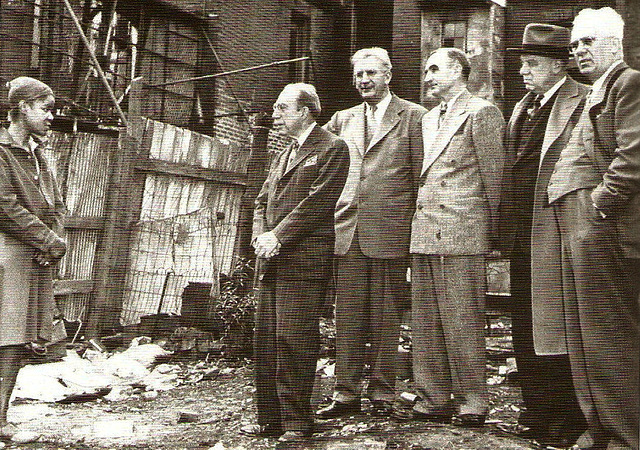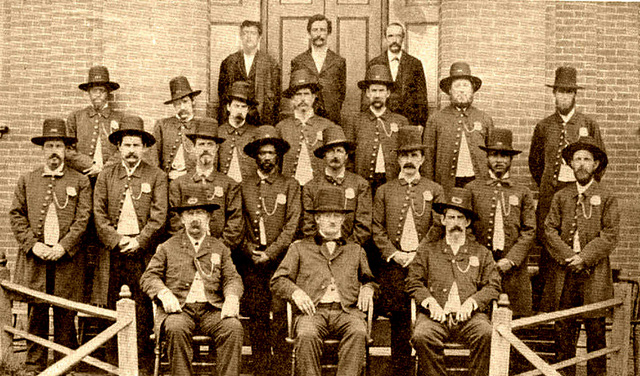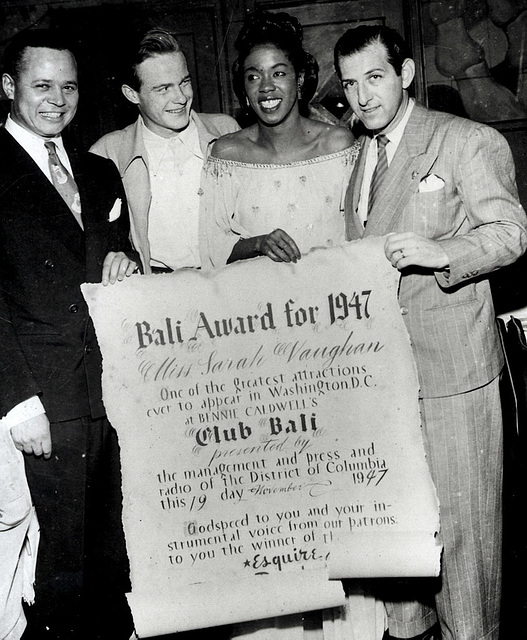
DC of Old
This set is all about my beloved hometown, Washington, DC. It's people, places and events.
--/--/----
Market Fare
This open air market was photographed in 1889 by B.W. Kilburn.
It depicts African Americans at an open-air market in Washington, most likely in the vicinity of the Center Market, where the National Archives building now stands. Many poor African Americans sold all manner of foodstuffs in what was likely the only venue available to them at that time--the market curbside, which they could occupy for free as long as they claimed their space before anyone else. In 1892, under the title, "War Didn't Efface Them," the Post reported on older African Americans that had survived slavery: "Here on every market day year in and year out are to be found the sturdy remnants of the old plantation stock. Nearly all of them own their own little patch of ground, and their stock in trade displayed on an upturned box or barrel consists of what they can raise with the hoe or glean from the wild products of the woods and fields."
Source: Lost Washington, D.C., by John DeFarrari (2011)
--/--/----
Miss Bessie Crocker
Indianapolis Recorder
November 11, 1939
First Colored Nurse Goes to Glenn Dale
Washington --- The fight waged by the Washington Tribune and several civic organizations to have colored nurses appointed at Glenn Dale Sanitorium bore fruit, last week, when Miss Bessie Crocker, graduate nurse from Suffolk, Virginia began her duties at the tuberculosis hospital, this week, as the first colored nurse to be assigned at Glenn Dale.
Miss Crocker completed her work at Freedman's Hospital in 1931. Since that time she has worked on private cases and at the time of her appointment, was a nurse in the Alexandria, Virginia Hospital. She resigned several days ago to accept the Glenn Dale appointment. Miss Crocker had worked in the Alexandria Hospital for about two years. She later passed successfully a Civil Service examination and other tests in connection with the position at Glenn Dale.
When the announcement was made several weeks ago that colored nurses would be eligible for appointment to the municipally supported institution a wave of protest went up from sixty white nurses at the hospital on the grounds that no separate accommodations are provided for colored nurses at the institution.
At the present Miss Crocker lives in the employees quarters and not in the nurses' home.
Other colored nurses are expected to be appointed later, the District Health Department disclosed, this week.
Sources: Hoosier State Chronicles (Indiana's Digital Historic Newspaper Program
--/--/----
Photo Op
From left to right: Senators Theodore Green, Paul Douglas, Wayne Morse, Raymond Baldwin, and Homer Ferguson. (circa 1940s).
Government officials toured throughout the Southwest part of DC to witness firsthand the conditions of the city's poor. A photographer captured this rather awkward moment of officials talking to a Southwest resident (name unknown). [ Images of America: Southwest Washington D.C.; by Paul K. Williams ]
--/--/----
3rd Precinct of the Washington Police Department
This is an 1876 photograph of the Washington Metropolitan Police Department. Simon West (4th from the left, 2nd row) handed President Ulysses S Grant a speeding ticket for riding his horse too fast down Pennsylvania Avenue. The president promptly paid the fine without any fuss.
Source: DC Public Library
--/--/----
Streetcar
A woman (name unknown) and passing streetcar on U & 7th Streets in Washington, DC., [ Images of America: Greater U Street; by Paul K Williams ]
--/--/----
Theatrical Troupe
Group of women (names unknown) from a theatrical group in DC, photographed by Addison N Scurlock in 1927,
--/--/----
Bali Award Winner of 1947: Sarah Vaughan
Bali Award for 1947: Miss Sarah Vaughan, one of the greatest attractions ever to appear in Washington, D.C., At Bennie Caldwell's Club Bali. Presented by the management and press and radio of the District of Columbia this 19th day November, 1947. Godspeed to you and your instrumental voice from our patrons to you the winner of Esquire. Club Bali was a black owned restaurant and nightclub located at 14th and T Street, NW.
The distinguished building at the northeast corner of 14th and T Street today houses a branch of the well known Arena Stage, but for many years it was an important African-American owned restaurant and nightclub known as Club Bali, one of the elite clubs nestled among the many venues that lined 14th and U Streets in the 1930s and 1940s that I researched as part of our work on the Greater U Street “City Within A City” Heritage Trail for Cultural Tourism DC. Its eventual decline hit a low with the 1975 murder of the owner in the building.
Club Bali opened in 1943, joining other watering holes in Washington such as Trader Vic’s in the Capitol Hilton. Club Bali was owned and operated for a time by Benjamin C. Caldwell, and featured live shows along with its own, fourteen piece orchestra located in a bandstand behind the bar.
The club headlined many important acts during the 1940s and early 1950s that played to mixed audiences of black and white patrons, similar to most of the U Street venues. Its cover charge of five dollars ensured an elite crowd of partygoers of the era.
Cab Calloway, Charlie Ventura, Louis Armstrong, Amos Williams, Ella Fitzgerald, Erol Garner, Johnny Hartman, Louis Jordan, Billie Holiday, Morgana King, Sarah Vaughan, Dinah Washington, and Charlie Ventura all performed at Club Bali. Sometimes referred to as the New Bali, it stood out among other venues in the neighborhood, however, by featuring a dinner menu of Korean cuisine, prepared by chef George Kim.
Billie Holliday played Club Bali in 1947 and in 1948, and returned to the Club’s successor, coined Cafe Trinidad, in 1954. Willis C. Nelson served as the musical director at the club for many years. Owner “Bennie” Caldwell was convicted of jury tampering in 1950 in the William “Snags” Lewis gambling and street numbers case, who had been one of his many patrons at Club Bali.
The building became a long succession of restaurants and clubs in the 1950s and 1960s, eventually becoming Jack Wiseman’s Lounge. Jack himself was murdered in his office in the rear of the building in 1975, in what police contributed to participation in a heroine drug ring. The case is still unsolved.
In 1984, the building was converted for use as a branch of Living Stage Theatre Company, founded by Robert A. Alexander in 1966 as a professional improvisational theater that offered participatory workshops to children, youth, teachers, parents, and community members. Living Stage’s main philosophy is based in the belief that everyone is born an artist and the act of creation is the ultimate act of self-affirmation.
Source: The Historical Society of Washington, D. C.; The House History Man Blog by Paul K. Williams
--/--/----
At the HU
A young African American man studies in his dorm room at historic Howard University in Washington DC., Addison N Scurlock, Photographer.
In November 1866, shortly after the end of the Civil War, members of the First Congregational Society of Washington considered establishing a theological seminary for the education of African-American clergymen. Within a few weeks, the concept expanded to include a provision for establishing a University. Within two years, the University consisted of the colleges of Liberal Arts and Medicine. The new institution was named for General Oliver O. Howard, a Civil War hero who was both a founder of the University and, at the same time, commissioner of the Freedman’s Bureau.
The University charter as enacted by Congress and subsequently approved by President Andrew Johnson on March 2, 1867, designated Howard University as “a University for the education of youth in the liberal arts and sciences.” The Freedmen’s Bureau provided most of the early financial support of the University. In 1879, Congress approved a special appropriation for the University. The charter was amended in 1928 to authorize an annual federal appropriation for construction, development, improvement and maintenance of the University.
In 1926, when Dr. Mordecai Wyatt Johnson, Howard’s first black president, assumed the presidency of Howard, the University was comprised of eight schools and colleges, none of which held national accreditation. The institution’s enrollment during this year stood at 1,700 and its budget at $700,000. By the time Johnson retired 34 years later, the University boasted of 10 schools and colleges, all fully accredited; 6,000 students; a budget of $8 million, the addition of 20 new buildings including an expanded physical plant; and a greatly enlarged faculty that included some of the most prominent black scholars of the day. Another key indicator of the University’s enhanced academic status was the 1955 inauguration of graduate programs that had the authority to grant the Ph.D degree.
Dr. Johnson’s successor was Dr. James M. Nabrit, Jr. who was previously Secretary of the University and Dean of the Law School. A leading constitutional lawyer and educator, Dr. Nabrit established at Howard in 1938, what is generally considered the first systematic course in civil rights in an American law school.
In 1969, Dr. Nabrit was succeeded by Dr. James E. Cheek, who had previously served as President of Shaw University in Raleigh, North Carolina. Dr. Cheek retired in June 1989. He was followed by an Interim President, Dr. Carlton P. Alexis, a physician/administrator who had been the University’s Executive Vice President and before that, its Vice President for Health Affairs.
On December 16, 1989, the Board of Trustees announced the appointment of Dr. Franklyn G. Jenifer to head the University. Upon his inauguration, Dr. Jenifer became the first Howard alumnus to head the University in its 123-year history. Dr. Jenifer served through May 15, 1994, when the Board of Trustees appointed Dr. Joyce A. Ladner as interim President. Dr. Ladner was the former Vice President for Academic Affairs and had also served as a professor in the School of Social Work.
On April 22, 1995, the Howard University Board of Trustees appointed H. Patrick Swygert to be its 15th president. Mr. Swygert is also the fifth African-American to serve as the University’s chief executive officer. H. Patrick Swygert received his undergraduate degree in history from Howard in 1965 and his law degree, cum laude, from the University’s law school in 1968.
In May 2008, the Howard University Board of Trustees announced the appointment of Dr. Sidney A. Ribeau as the 16th president of Howard University, to lead the institution into a new phase of growth as the nation’s premier Historically Black College and University. Dr Ribeau began his tenure on August 1, 2008.
Today, Howard University is one of only 48 U.S. private, Doctoral/Research-Extensive universities, comprising 12 schools and colleges with 10,500 students enjoying academic pursuits in more than 120 areas of study leading to undergraduate, graduate, and professional degrees. The University continues to attract the nation’s top students and produces more on-campus African-American Ph.D.s than any other university in the world. Since 1998, the University has produced a Rhodes Scholar, A Truman Scholar, six Fulbright Scholars and nine Pickering Fellows.
In addition to President H. Patrick Swygert, Howard’s notable alumni include: the late U.S. Supreme Court Justice Thurgood Marshall; the first African-American governor L. Douglas Wilder; Nobel Laureate and Pulitzer Prize-winning author Toni Morrison; Savage Holdings LLC CEO and Howard Board of Trustees Chairman Frank Savage; Emmy Award-winning actress Phylicia Rashad; opera singer Jessye Norman; actress, producer and director Debbie Allen; the first African-American president of the American College of Surgeons, Dr. LaSalle Leffall, Jr.; attorney, civil rights leader and Wall St. executive Vernon Jordan; former mayor and United Nations Ambassador Andrew Young; and the first female mayor of Atlanta, Shirley Franklin. A list of Howard distinguished faculty members through the years reads like a “Who’s Who in Black America.” Among them: Ralph J. Bunche, Political Science; Charles R. Drew, Medicine; E. Franklin Frazier, Sociology; Alain J. Locke, Literature; Carter G. Woodson, History; and Lois Mailou Jones, Art.
Sources: Photography by J.W. & J.S. Moulton, Legacy: Treasures of Black History; Edited by Thomas C Battle and Donna M Wells, Moorland-Spingarn Research Center
--/--/----
Wake-Robin Golf Club
The Wake-Robin Golf Club (WRGC) is a minority women’s golf club founded April 22, 1937, by Helen Webb Harris. It is the oldest registered African-American woman’s golf club in the United States. WRGC is a 501(c)(3) non-profit corporation that introduces women to the game of golf and provides them with the abilities/skills to participate in amateur competitive golf events. [Above are members of the Wake-Robin Golf Club, in Washington, D.C.]
The first meeting was held at the home of Helen Webb Harris at 79 R Street NW, Washington DC. There were thirteen women in attendance. Mrs. Harris, an educator, was the wife of a prominent Washington physician. The founding members, several of whom were wives of Washington’s all-Black, all-male Royal Golf Club, Inc., were tired of staying home on weekends while their husbands played golf. Named after the purplish Wake-Robin wild flower plentiful in the Mid-Atlantic region, the club blossomed almost from the start though not without a few problems. In 1938, WRGC pushed the process of desegregating the public courses of the District of Columbia by drafting and sending a petition to Secretary of the Interior Harold Ickes. To mollify the petitioners, the Secretary approved the construction of a nine-hole course on the site of an abandoned trash dump. In 1939, Langston Golf Course was built near Spingarn High School in Northeast Washington, DC. It wasn’t pretty, especially when players tried to retrieve balls from under the old tires or rusty tin cans strewn about the property; but, finally Black golfers had a place to call their own. Both WRGC and the Royal Golf Club, Inc., continued to press Secretary Ickes to desegregate the city’s other public facilities. In 1941, he issued an order opening public golf courses to all.
Mission, Core Values and Goals
Our mission is to foster and perpetuate women’s interest in golf and encourage women in Washington, D.C. and vicinity to become golfers. We are the premier force for promoting and advancing women’s interest in golf.
The WRGC believes in and conducts itself according to the values embodied by the game of golf: Honesty, Integrity, Respect, Honor, Sportsmanship, Fun and Friendship.
Core Values - Inclusiveness and Diversity ~ Volunteer Service ~ Mentoring and Support for New Golfers ~ Advancement of Golf Skills for all Golfers ~ Making a Difference for Women’s Golf ~ Professionalism in our operations and relationships.
Goals - To provide premier programs for WRGC members in golf education ~ player skill development and organized play ~ To provide timely and valued benefits and services to WRGC members and volunteer leaders ~ To promote the growth of women’s golf ~ To be an advocate for positive change on issues of importance to women golfers ~ To assist in educating, promoting, training, supporting ~ encouraging young golfers to seek golf scholarships and associated programs.
wake-robingolf.org; Afro American Newspapers/Gado/Getty Images
Jump to top
RSS feed- Latest items - Subscribe to the latest items added to this album
- ipernity © 2007-2025
- Help & Contact
|
Club news
|
About ipernity
|
History |
ipernity Club & Prices |
Guide of good conduct
Donate | Group guidelines | Privacy policy | Terms of use | Statutes | In memoria -
Facebook
X










